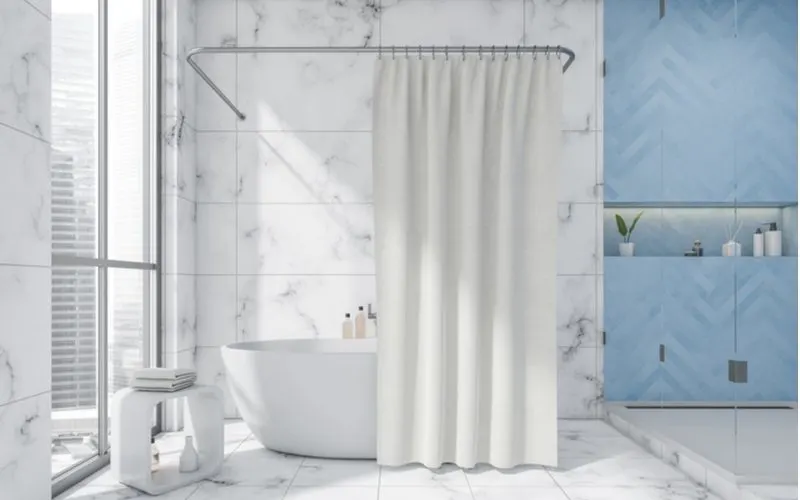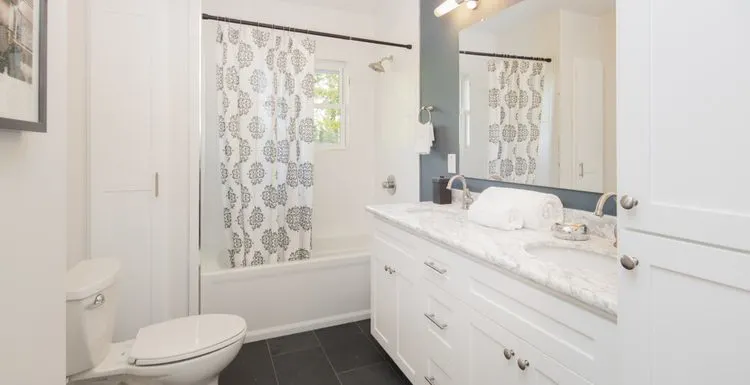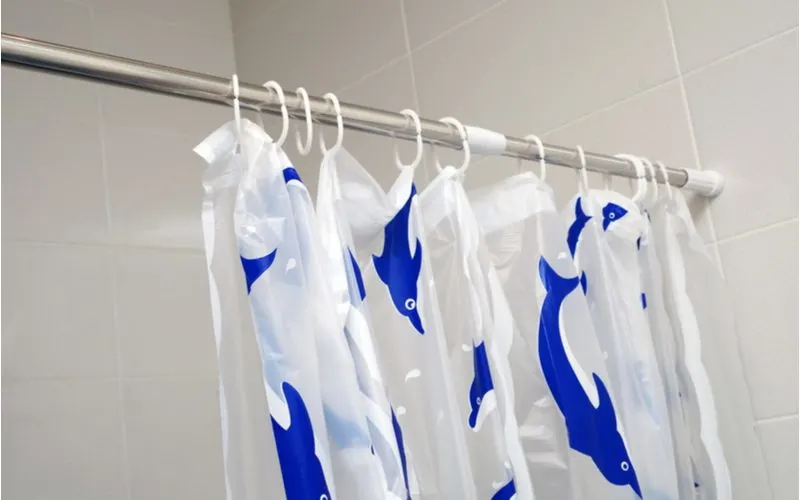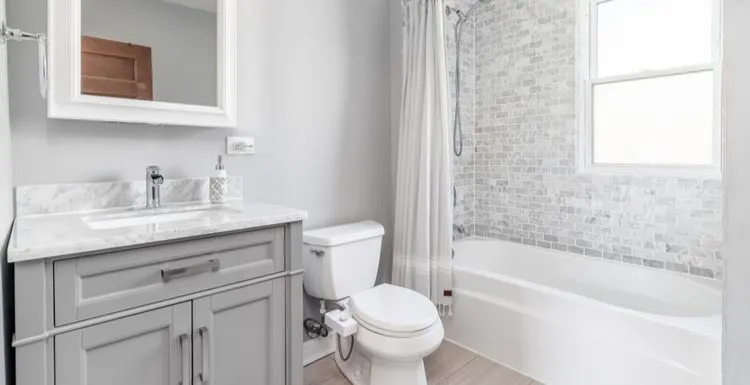Homeowners looking to save a little money might explore using shower liners to cover tile in a bathroom.
This guide will cover everything you need to know about these materials for your next remodeling job.
Can You Cover Tile With a Shower Liner?
Yes, you can use shower liners to cover the tile in your bathroom if you need to change or update your décor.
However, the type of material may vary, and the costs will depend on the size of your bathroom space or if you have asbestos.
Pros
- It is expensive compared to other materials
- Straightforward for DIYers
- Less time-consuming
- Less complex procedure
- Durable and mold- and mildew-resistant
Cons
- Not all homeowners will have the right tools to do the job themselves
- Tiles will still need cleaning and preparation before installing a liner
- Prices can be higher for specialty liners of unique sizes or styles
Using Shower Liners to Cover Tile

ImageFlow/Shutterstock
Shower liners to cover tile can be inexpensive and less complex than other remodeling alternatives.
However, some elements can affect this project, and you need to ensure that your shower space remains protected against mold, mildew, and water.
The Reason for the Renovation
The reason you want to renovate your bathroom can make choosing a shower liner the best option possible.
- Are you on a strict budget and need a practical and inexpensive way to redo the shower space?
- Do you want to perform the task yourself or do you need a professional?
- Are you short on time to complete the renovation or need a workable solution that’ll be functional in less time?
- Are the tiles so damaged that removing them to re-tile would take a significant amount of time and money?
- Would you prefer a solution that has less chance of mildew or bacteria buildup?
All these situations can benefit from using a shower liner in your bathroom space.
Budget Needs
Shower liners, sometimes called shower panels, are relatively inexpensive compared to other materials.
They come in various types, including PVC, acrylic, fiberglass, water-resistant MDF, or similar materials.
These materials are significantly less expensive than other alternatives, including natural stone, glass, or assorted tiles.
DIY Projects
Using a shower liner to cover bathroom tile is a simple task that many DIYers can handle as a weekend project.
Installing a shower liner or panels is straightforward as long as you have the correct tools and complete each step correctly.
Shower liners also make a DIY project less extensive than a complete re-tiling job, ensuring that the homeowner does not need to have many home renovation skills to do it successfully.
Time Restrictions
Homeowners who are short on time or need a finished solution quickly can benefit from a shower liner installation.
For example, where re-tiling a bathroom space can take upwards of two days or more, you can install a shower liner in about two hours and be ready to use within the day.
Many individuals cannot spare days or weeks remodeling their bathroom area. Shower liners help save time by making the task easy and quick, getting the space back to functionality as soon as possible.
Less Invasive Process
Naturally, covering existing tiles will be less invasive than removing the tiles and reinstalling new ones.
Even homeowners who have to hire a professional to install their shower liner over current tiles will find they pay less for labor costs than if they chose a different method.
This process requires fewer tools and elbow grease, making a significant difference for many homeowners who want to finish the job themselves.
Relatively Maintenance-Free
This renovation method is virtually maintenance-free because of the impermeable elements of shower liner materials.
As long as these panels are installed and sealed correctly, water cannot enter to create any mold or mildew buildup. These materials don’t include grout, which can harbor bacteria over time.
As a result, they are easy to keep clean and require virtually no maintenance when installed properly. This feature can save a homeowner many hours of regularly cleaning their bathroom.
Things to Consider

BondRocketImages/Shutterstock
Before choosing to go with a shower liner to cover bathroom tile, consider these factors:
- Is your bathroom space a standard size, or would you need a custom-made shower liner?
- Do you have a preference for material to use?
- Will you cover the shower tiles only, or do you also want to include the tub?
- Do you have a specific style in mind?
Bathroom Size
As with any renovation, if your space requires unique measurements that are not a standard size, you may find that the overall costs will increase.
Prices for materials can fluctuate when manufacturers have to individually cut and prepare shower liners to fit a specific space rather than an average bathroom area.
Before choosing a shower liner, remember to ensure that it is slightly smaller than your current décor to fit over the existing tile and surfaces without issues.
Material Preference
Do you prefer PVC, water-resistant MDF, or acrylic?
While many shower liner materials are inexpensive, some textiles will still be pricier than others. If you have a preference for material, it could also affect how you install the liner or require additional tools.
Tiles Only or With a Tub Surround?
Some homeowners will purchase a shower liner to only cover the tile around the bathroom area above the tub.
Other individuals will prefer to use a two-piece kit that will seal the surrounding walls and the tub simultaneously.
Naturally, opting for both pieces will cost more, but homeowners may find fewer problems when the entire space has proper sealing.
Style Preference
As with any renovation, the fancier you want the space to look, the more you will pay for the task. Consequently, standard plain white shower liners will, on average, be the less expensive option available.
However, if you want to update the style in the bathroom to reflect a more modern décor, you could be looking at more costly materials that resemble marble or tiles.
8 Steps to Cover Tiles With a Shower Liner
Homeowners can use a shower liner to cover old bathroom tiles in only eight easy steps.
1. Gather the Necessary Tools
DIYers will need the essential tools to perform this job correctly. Gather these items before attempting to install a shower liner on your own:
- Tape measure
- Safety glasses
- Caulking gun
- Sandpaper
- Adhesive sealant
- Sharp blade
- Electric saw
- Sealant kit
2. Measure the Area
Measure the length and width of the space you are covering. It’s always a good idea to measure twice, once from left to right, then right to left. Then, follow the same procedure from top to bottom and from bottom to top.
This way, you will be sure of the space before cutting panels or ordering the shower liner. Remember to also measure the distance for the available fixtures that will need openings.
3. Remove the Fixtures
The taps, faucet, and other fixtures will need to be removed to fit the shower line into the space.
4. Clean the Tiles and Grout
You do not want to cover any existing problems, like mold or mildew. Before installing a shower liner, clean the tiles and grout thoroughly with an anti-bacterial solution.
You want to ensure that you eliminate any chances of mold growth under the liner, which can cause problems later.
Removing the fixtures before this allows you to successfully clear away any buildup under the taps or faucet before putting the new shower liner on.
5. Rough Up Tile Surfaces
Now that the area is clean, you will use sandpaper to rough up the tile surfaces so the adhesive sticks to keep the liner in place.
You want to be sure there is no chance of contact with asbestos during this process. A smooth surface makes it easier for the liner to move if the adhesive doesn’t stick properly.
6. Cut the Trim Pieces and Install in Place
You can cut the trim pieces using your previous measurements with an electric saw.
They will go around the edges of the section where you plan to put the liner. Use the adhesive and secure the trim in place.
7. Apply the Adhesive, Install the Shower Liner, and Seal the Edges
Use enough adhesive to cover the tile where the shower liner will go and secure it in place within the trim. Remember to cut out the sections where you will reattach the fixtures once they are in place.
Depending on your space, you may need a second person to help maneuver the liner to the proper position.
Once it’s in the correct spot, remember to use caulking to seal all the edges, preventing water from getting underneath the liner. Without it, you risk having mold or mildew problems soon after this renovation.
8. Reinstall the Fixtures, New Drain, and Stopper, Then Seal
Finally, you can reinstall the fixtures, stopper, and new drain on the shower liner.
Once everything is back, use your caulking to seal the edges around the fixtures to prevent water from penetrating under the liner.
Frequently Asked Questions

gmstockstudio/Shutterstock
For any other concerns or inquiries, be sure to read the frequently asked questions below for more information.
Can I install a shower liner without removing the old tiles?
Yes, you can install the shower liner entirely over the old tiles without removing them.
However, the tiles need to be clean and prepped before the installation to ensure that you will not be sealing over an existing bacteria growth. Preparing the tiles will also ensure that the shower liner remains properly.
Will a shower liner give the bathroom a more updated look?
Many shower liner styles can give a bathroom a more modern look to old, outdated tiles.
There are numerous designs in the market that range from solid colors to patterns, and some even resemble tiles, providing a terrific alternative for many spaces.
How much does it cost to install a shower liner?
The cost of installing a shower liner will range, depending on the size and style.
However, homeowners can expect to pay anywhere from $500 to around $3,000. This amount will depend on if they handle the job on their own or hire a professional.
What is an average bathroom remodel cost?
Remodeling bathrooms that do not use a shower liner can cost between $3,000 and $5,000 or more, depending on the space and materials used.
This price is significantly more than a budget-friendly shower liner remodeling option.
Do all shower liners look the same?
No, shower liners come in all sorts of colors, patterns, and styles to choose from, so homeowners can match their current décor.
Although the typical model will be basic white, homeowners can select ones that resemble marble or tile, even though it uses different materials, like PVC or acrylic.
So, Can You Use Shower Liners to Cover the Tile?
For any homeowner looking for a more cost-effective or less invasive solution to a bathroom renovation, a shower liner to cover tile can be a terrific alternative.
This project takes less time and money but will still provide a functional and beautiful result.

